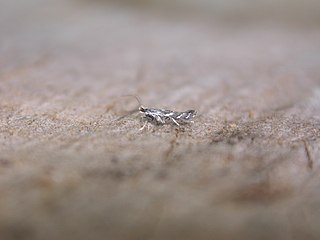Genophantis leahi was a species of moth in the family Pyralidae described by Otto Herman Swezey in 1910. It was endemic to the Hawaiian islands of Maui, Oahu, Molokai and Hawaii.
Agonoxena argaula, or the coconut flat moth, is a moth of the family Agonoxenidae. It was first described by Edward Meyrick in 1921 from Fiji and is also known also from Guam, the New Hebrides, Tonga, Samoa, Ellice, Wallis, Futuna, and the Palmyra Atoll. It was first recorded in Hawaii in 1949. It is artificially spread by commerce.
Perittia lonicerae, the honeysuckle leaf miner, is a moth of the family Elachistidae. It was first discovered in Hawaii in 1949. It was later found in Japan in 1982, although it was described as new. Several other species are known from the eastern Palearctic Region, so it is likely that P. lonicerae originated there instead of Hawaii where it was first found.
Paralopostega callosa is a moth of the family Opostegidae. It was first described by Otto Swezey in 1921. It is endemic to the Hawaiian island of Oahu, where it is thought to be widespread in the Koʻolau Range.
Omiodes accepta, the sugarcane leafroller, is a moth of the family Crambidae. It is endemic to the Hawaiian islands of Kauai, Oahu, Molokai, Maui and Hawaii.
Omiodes monogona, the Hawaiian bean leafroller, is a moth of the family Crambidae. It is endemic to the Hawaiian islands of Kauai, Oahu, Molokai, Maui, Lanai and Hawaii. It was first cited as possibly extinct by the U.S. Fish & Wildlife Service in 1994. It was listed as extinct by the Hawaiʻi Biological Survey in 2002, but was rediscovered later in 2003.
Omiodes monogramma is a moth of the family Crambidae. It is endemic to the Hawaiian islands of Kauai, Oahu, Molokai and Hawaii.
Omiodes scotaea is a moth of the family Crambidae. It is endemic to the Hawaiian islands of Oahu, Molokai and Hawaii.
Philodoria hibiscella, the hibiscus leaf miner, is a moth of the family Gracillariidae. It was first described by Otto Swezey in 1913. It is endemic to the Hawaiian islands of Oahu and Hawaii.
Philodoria basalis is a moth of the family Gracillariidae. It was first described by Lord Walsingham in 1907. It is endemic to the Hawaiian islands of Maui and Hawaii.
Bucculatrix thurberiella, the cotton leaf perforator, is a species of moth of the family Bucculatricidae. It was first described by August Busck in 1914. It is native to the south-western United States and northern Mexico. It is an introduced species in Hawaii.
The Russian thistle casebearer is a moth of the family Coleophoridae. It is native to Asia Minor and central Asia, but has been introduced to California, Texas and Hawaii.
Lyonetia bakuchia is a moth in the Lyonetiidae family. It is known from Japan.
Hellinsia nigridactylus is a moth of the family Pterophoridae. It is known from Japan, Korea, China and Russia.
Phyllonorycter cephalariae is a moth of the family Gracillariidae. It is known from southern France, Croatia, Greece, Hungary and Serbia.

Parornix finitimella is a moth of the family Gracillariidae. It is found in nearly all of Europe, except Ireland, the Iberian Peninsula and parts of the Balkan Peninsula.

Aspilapteryx tringipennella is a moth of the family Gracillariidae. It is known from all of Europe.

Leucospilapteryx omissella is a moth of the family Gracillariidae. It is known from all of Europe, east through Russia to Japan.
Aristaea bathracma is a species of moth of the family Gracillariidae. It is known from China, Thailand, Japan (Honshū), the Russian Far East, Mozambique, South Africa, Réunion and Uganda.

Coleophora ledi is a moth of the family Coleophoridae. It is found from Fennoscandia and northern Russia to the Pyrenees and the Alps. In the east, it ranges to Japan. Outside of Eurasia, it is known from North America where it is found in eastern Canada, Michigan, and Alaska.



